This post contains affiliate links. Please see our disclosure policy.
This Okonomiyaki recipe brings you a Japanese pancake full of savory flavors and crispy ingredients, and it’s easy to make at home!
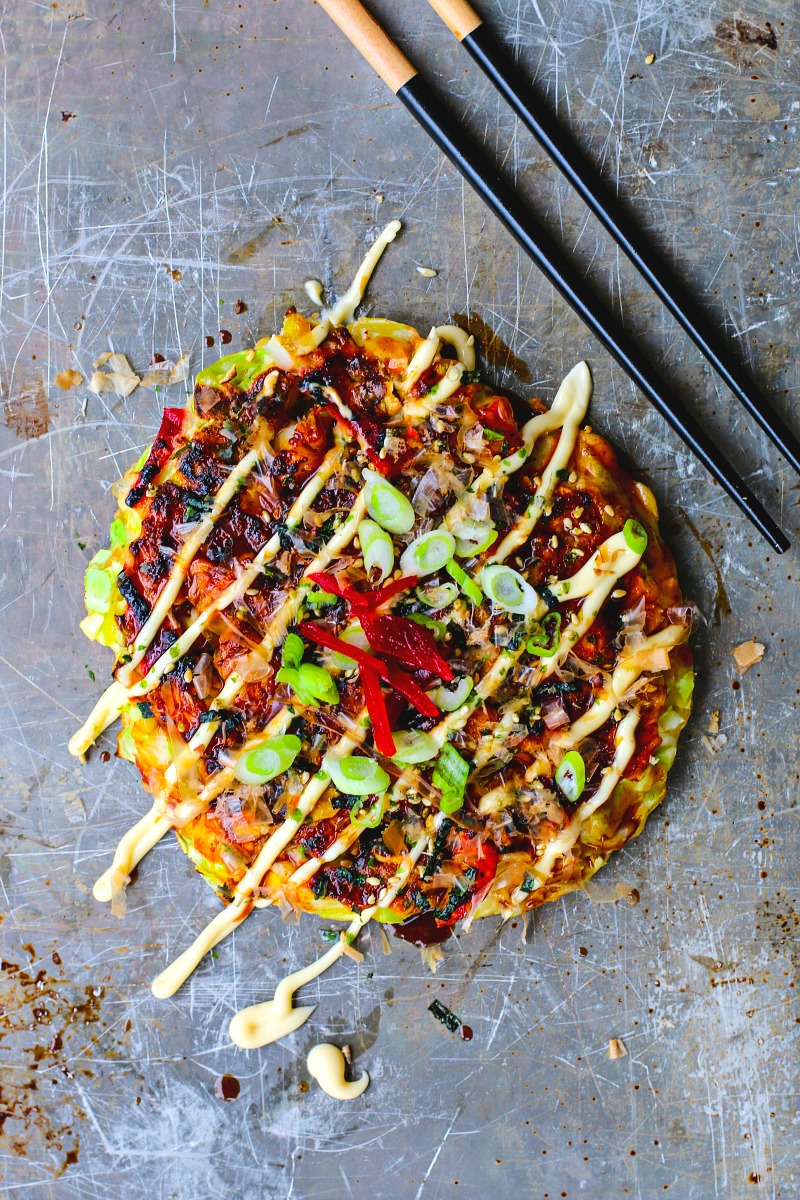
You Need This Okonomiyaki Recipe in Your Life Stat.
This colorful savory Japanese pancake is the thing that dreams are made of. It’s crunchy, salty, sweet, and bursting with umami. I found myself surprised with how many local Japanese restaurants offer it once it was brought into my awareness. So, stay on the lookout for Okonomiyaki the next time you’re eating at a Japanese establishment! And if you can’t find it on your local menus, don’t fret. If you hit up your local Asian grocer for the right ingredients, it’s easy to make this okonomiyaki recipe right at home.
What Is Okonomiyaki?
The name okonomiyaki translates to “grilled how you like”. Some restaurants that specialize in okonomiyaki offer up a diner-style counter, where the chef prepares the dish in front of the patrons. Other restaurants pride themselves in being a grill-it-yourself establishment. Here, guests have the chance to be their own chef with hotplates and bowls of uncooked ingredients.
There are several versions of this dish, including modan-yaki (served with a layer of fried noodles) and negiyaki (a thinner pancake that incorporates a lot more scallions), but okonomiyaki is the most predominant throughout the majority of Japan. Most of the ingredients are common and include eggs, flour, cabbage, and dashi. But there are a few ingredients that might be new to you: nagaimo, Japanese mayonnaise (Kewpie mayo), and red pickled ginger.
Nagaimo:
Simply put, nagaimo is a Chinese yam. But it’s got a little more to it than the beloved yams we know and love in the US. It’s actually advised to wear gloves while handling the nagaimo as it can cause irritation to the skin (nothing serious, more annoying than anything). In this recipe, the nagaimo is grinded down to a gooey and almost gelatinous purée using a microplane, or the small, rough holes on your box cheese grater. This purée is called the tororo, and it’s what gives okonomiyaki it’s fluffy texture.
Japanese Mayonnaise:
Japanese mayonnaise (Kewpie mayo) is the best mayonnaise, that’s what it is. You’re probably wondering how it differs from mayo as we know it, so here’s the gist. The mayo we grew up on here in the US is made up of whole eggs and white vinegar, while Kewpi mayo uses egg yolks—without the whites—and apple cider or rice vinegar. Because of this, the flavor is richer, tangier, and sweeter.
Red Pickled Ginger:
Primarily known as Beni Shoga, red pickled ginger is young ginger that’s been julienned and pickled in plum vinegar. Store-bought variations are a deep red hue, which offers an eye-popping presentation. As for flavor, it’s zippy and refreshing! A fantastic condiment for okonomiyaki.
The Ingredients for This Okonomiyaki Recipe.
Most of the ingredients in Okonomiyaki can be found at your usual grocery store. But a few of the items will require a trip to an Asian grocer! Which is always a treat anyway, so consider that a win. Here’s what you’ll need:
Okonomiyaki Pancakes:
- All Purpose flour
- Kosher salt
- Sugar
- Baking powder
- Nagaimo
- Dashi
- Cabbage
- Eggs
- Shrimp chips or tempura bits
- Pickled red ginger
- Vegetable oil
Okonomiyaki Sauce:
- Raw honey
- Oyster sauce
- Sriracha sauce
- Worcestershire sauce
Garnishes:
- Japanese mayonnaise (Kewpie mayo)
- Katsuobushi
- Scallions
- Nori Komi Furikake or dried green seaweed powder
- Thinly sliced pickled red ginger
How to Make Okonomiyaki.
This recipe is perfect for homecooks who enjoy Japanese cuisine and like to challenge themselves with new ingredients. The process isn’t difficult, but it’s definitely different than anything I’d ever made before.
Prepare the okonomiyaki sauce:
- In a small bowl, whisk together the honey, oyster sauce, Sriracha, and Worcestershire sauce. Set it aside.
Okonomiyaki:
- In a large bowl, combine the flour, salt, sugar and baking powder; blend until well blended and set it aside.
- Peel the nagaimo and grate it into a small bowl. The consistency will be somewhat slimy, and that’s normal.
- Transfer the grated nagaimo to the bowl of dry ingredients and add the dashi. Whisk it until combined, then cover and refrigerate it for an hour.
- In the meantime, prepare the rest of your ingredients—cook any meats you plan to add, prepare your Okonomiyaki Sauce, and mince your cabbage. If your cabbage has a lot of moisture, press it with a paper towel and set it aside to let the moisture evaporate so it doesn’t dilute the batter. Once the batter has been in the fridge for an hour, add the eggs, the chopped shrimp chips or tempura scraps, and the pickled red ginger. Stir everything until it’s well-combined.
- Fold the cabbage into the batter about 2 cups at a time, stirring well in between.
- Heat the vegetable oil in a large skillet over moderate heat. Carefully spoon the batter in a circle on the pan (about 2 cups worth).
- If you’re using meat, place is on top of the pancake and lightly press it into the batter to secure it. Cover and cook for 5 minutes. Once the bottom side is nicely browned, carefully flip it over and gently press down on the okonomiyaki to reshape it and keep it together. Cover it and cook it for another 5 minutes.
- Flip over one last time and cook, uncovered, for 2 minutes.
- Transfer to a plate or baking sheet and continue with the others until done.
- When done, brush the Okonomiyaki sauce over the tops of the pancakes, then drizzle them with the Japanese mayo in zigzagging lines. Sprinkle some katsuobushi over them, then add the other toppings. In my case, it was Nori Komi Furikake, thinly sliced scallions, and thinly sliced pickled red ginger.
Equipment You’ll Need:
- Sharp knife
- Cutting Board
- Cast iron skillet or Non-stick skillet
- Box cheese grater or Microplane
- Spatula
Recipes Tips + Tricks.
- Okonomiyaki freezes well. Once cooled, wrap each in aluminum foil and place in a freezer bag. When you want to eat one, take it out, let it thaw and put it in the oven at 350 degrees until it reaches your preferred temperature.
Have You Made This Recipe?
If you enjoyed this recipe, please consider leaving a STAR rating & commenting below with feedback!
You can also show off your creations on Instagram by tagging @killing__thyme

Okonomiyaki Recipe
Ingredients
Okonomiyaki:
- 1 cup all-purpose flour
- 1/4 tsp kosher salt
- 1/4 tsp sugar
- 1/4 tsp baking powder
- 2-3 inch piece of Nagaimo/Yamaimo
- 3/4 cup dashi or 3/4 cup water with 1 tsp of dissolved dashi powder
- 1 large head of cabbage, approx. 8 cups
- 4 large eggs
- 1/2 cup roughly chopped shrimp chips or tempura scraps, Tenkasu/Agedama
- 1/4 cup pickled red ginger, Kizami Beni Shoga, thinly sliced
- Vegetable oil
Okonomiyaki Sauce:
- 1.5 TBSP honey
- 2 TBSP oyster sauce
- 4 TBSP Sriracha sauce, if you want to avoid spicy, you can use ketchup
- 3.5 TBSP Worcestershire sauce
Garnishes:
- Okonomiyaki sauce
- Japanese mayonnaise
- Katsuobushi
- Thinly sliced scallions
- Nori Komi Furikake or dried green seaweed powder
- Thinly sliced pickled red ginger
Adding meats:
- Some folks enjoy the addition of meat to their okonomiyaki. I like to add cooked and roughly chopped shrimp to mine, but you can also use squid or any other meats you fancy. Simply add your meats to the top of the pancake when you initially spoon it onto the pan and press down with a spatula to secure. I always cook my fish prior to this step to avoid it from being undercooked.
Instructions
Okonomiyaki Sauce:
- In a small bowl, mix together the honey, oyster sauce, Sriracha and Worcestershire sauce. Set aside.
Okonomiyaki:
- In a large bowl, combine the flour, salt, sugar and baking powder; whisk until well blended. Set aside.
- Peel the nagaimo and grate it into a small bowl.
- Add the grated nagaimo and dashi to the bowl of dry ingredients. Whisk until combined, cover and refrigerate for an hour.
- In the meantime, you can cook any meats you plan to add, prepare your Okonomiyaki Sauce and mince your cabbage, core removed. If your cabbage is very moist, press with a paper towel and set it aside to let the moisture evaporate so that it doesn't dilute the batter.
- Once the batter has been in the fridge for an hour, remove it and add the eggs, the chopped shrimp chips or tempura scraps and the pickled red ginger. Stir until well-combined.
- Add the cabbage to the batter approx. 2 cups at a time. Stir well before adding the rest.
- In a large pan, heat the vegetable oil over moderate heat.
- Carefully spoon the batter in a circle on the pan (approx. 2 cups worth).
- If using meat, place is on top and lightly press into the wet batter to secure. Cook covered for 5 minutes.
- Once the bottom side is nicely browned, carefully flip it over.
- Gently press down on the okonomiyaki to reshape (if needed) and keep it together.
- Cover and cook for another 5 minutes.
- Flip over one last time and cook, uncovered, for 2 minutes.
- Transfer to a plate or baking sheet and continue with the others until done.
Assembly:
- Brush the Okonomiyaki Sauce over the top surface of the pancake, then drizzle the Japanese mayo over it in zigzag lines. Sprinkle some katsuobushi over it, followed by your other toppings. In my case, it was Nori Komi Furikake, thinly sliced scallions and thinly sliced pickled red ginger.
Notes
* Okonomiyaki freezes well. Once cooled, wrap each in aluminum foil and place in a freezer bag. When you want to eat one, take it out, let it thaw and put it in the oven at 350 degrees until it reaches your preferred temperature.
Resources
- JustOneCookbook.com — It’s safe to say that 90 percent of what I’ve learned in Japanese cooking has come from Nami and her amazing blog. Nami, if you read this, thank you.
- Serious Eats
- Wikipedia
- Okonomiyaki World
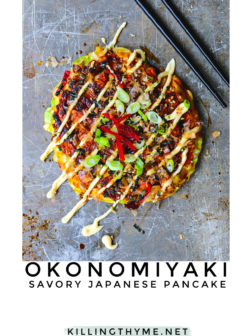

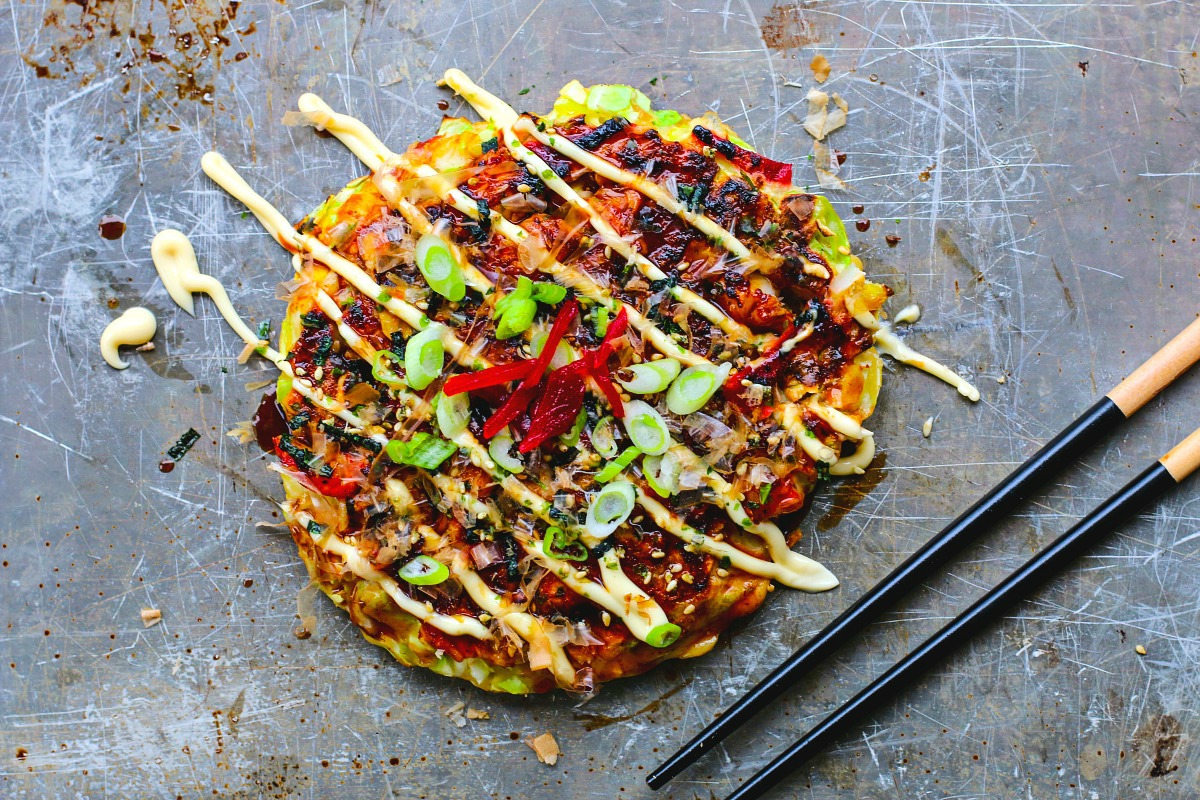
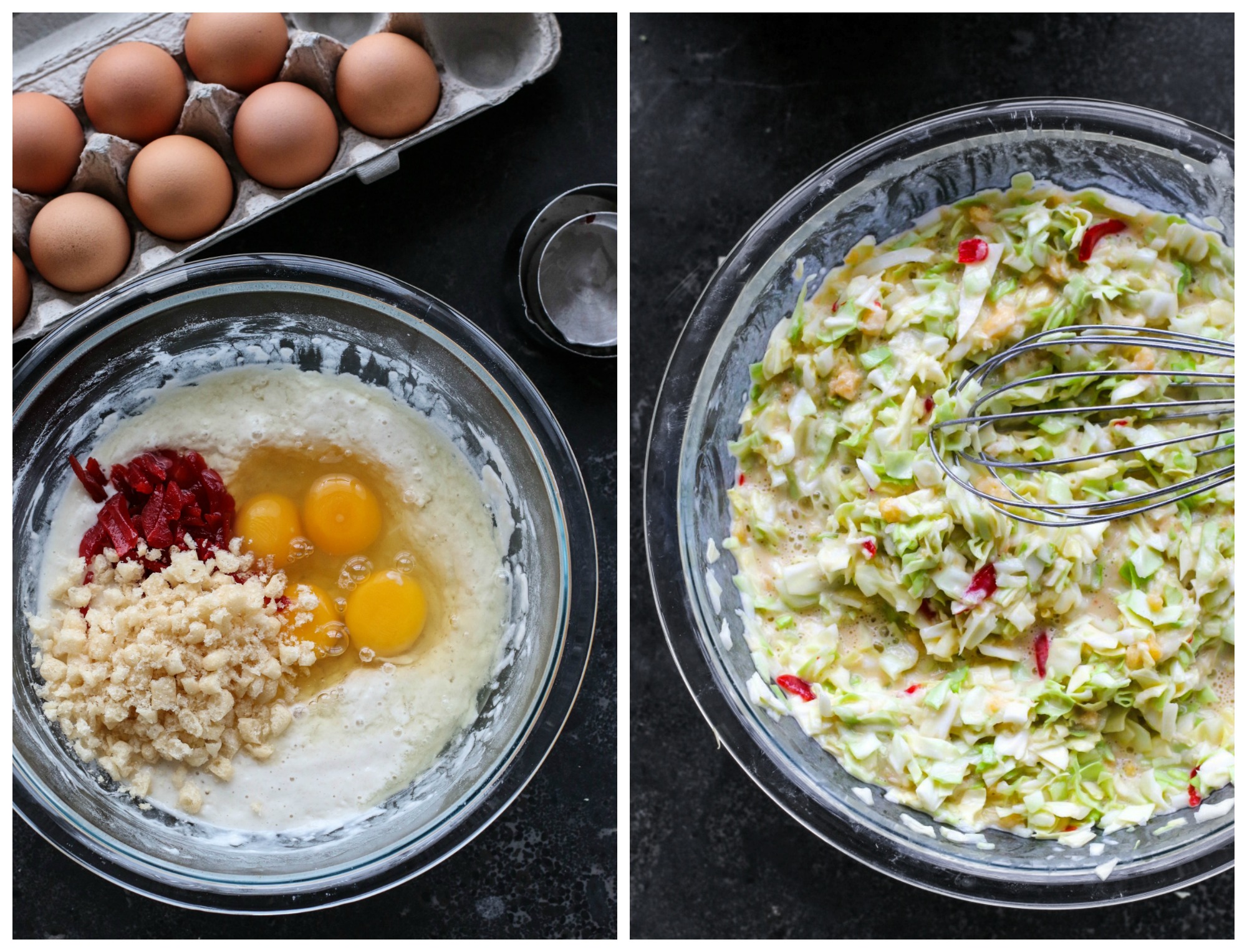
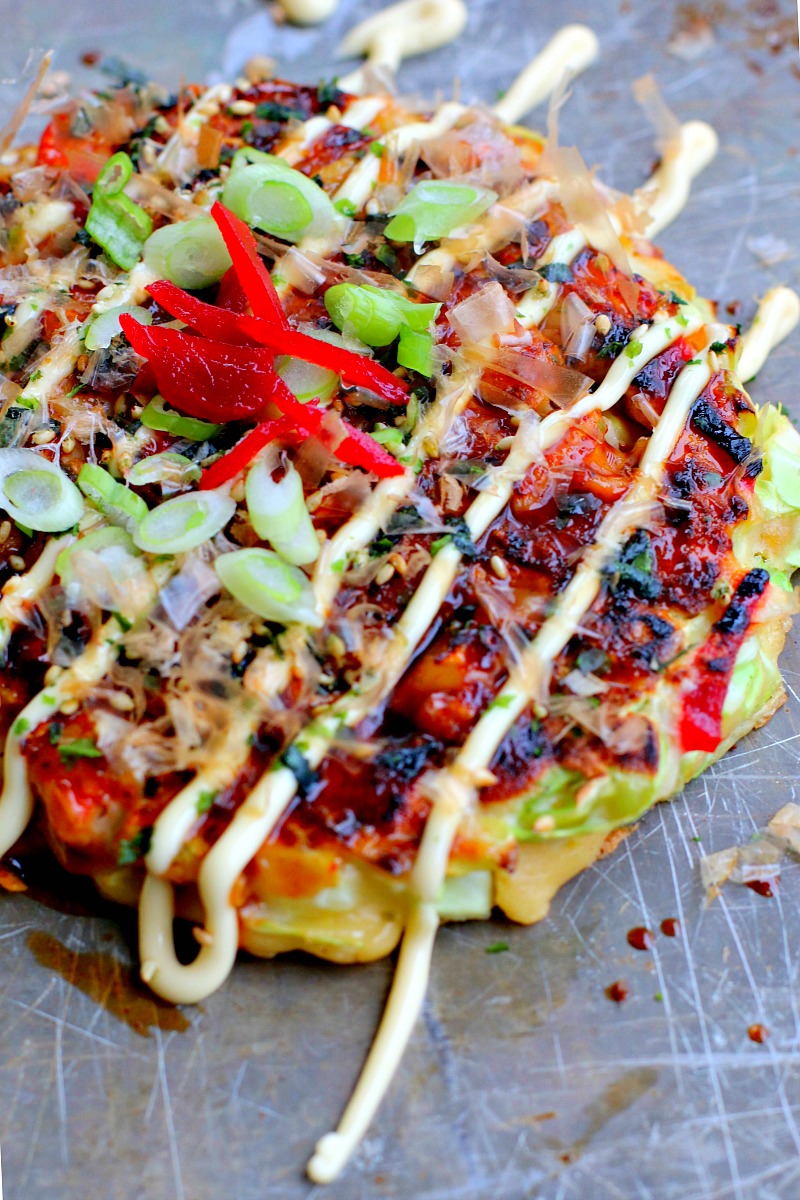
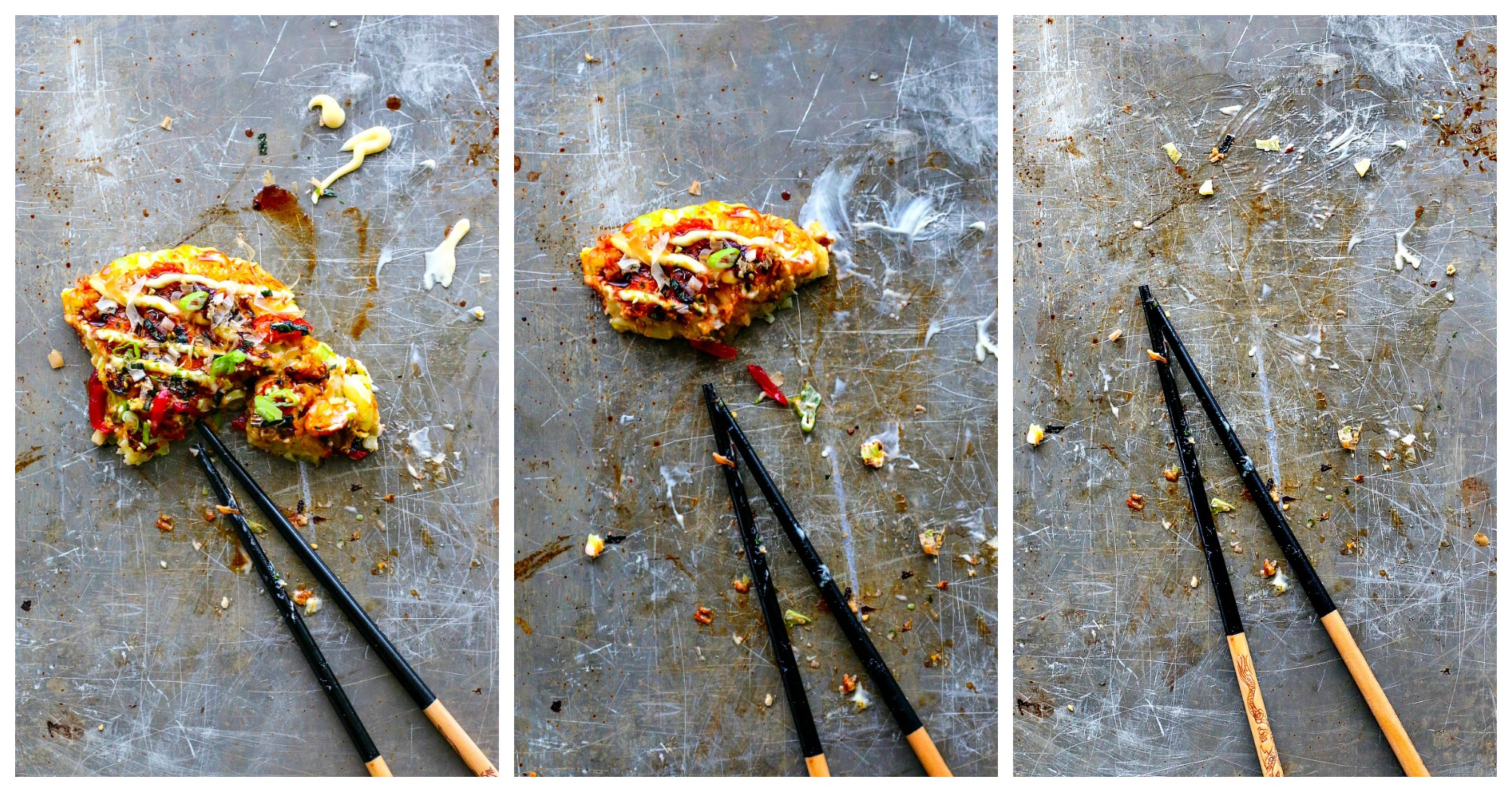
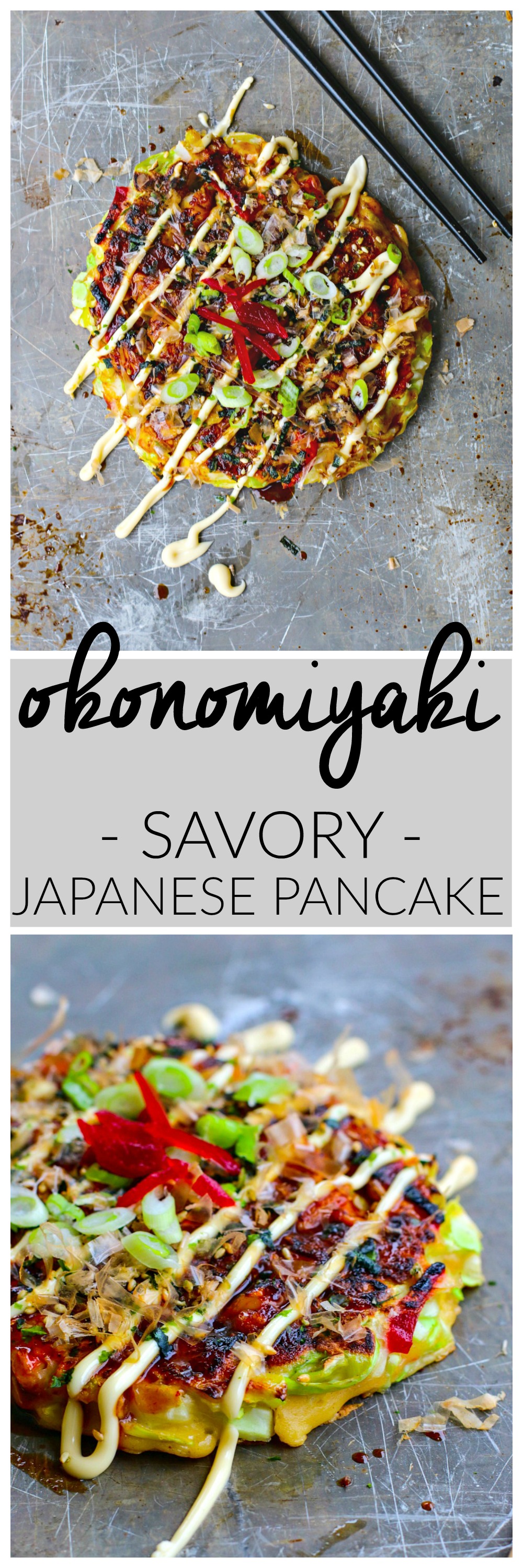






Your pancake looks so yummy. It must be really flavourful. I am sure going to try it. Thanks for sharing.
Thanks so much, Fouzia! Let me know how you like it :)
This looks like a bomb of flavours! I’ve never heard of Okonomiyaki before, thanks to you it’s seriously on my radar… Looks so yummy!
I’m glad I’ve enticed you with this, Marie! It totally is a flavor bomb and it’s one of those things that leave you wanting another one, but you know you shouldn’t… haha.
I’ve had Korean pancakes before but never Japanese ones. These look amazing and full of great flavours! I’ve pinned it for later :)
I’ll have to check Korean pancakes out! Thanks, Shareba. I think you’d love these — they are full of umami. Coming back to this post has me craving them all over again.
This recipe totally jumped out at me, screaming ‘Try Me!”, so I guess I’ve gotta listen. It sounds absolutely delicious. I love egg-based recipes. I’m going to look for the Chinese yam in our Asian supermarket and hope to find it. I know you said it’s optional, but would it work to substitute regular grated yam or sweet potato if I can’t find it? I’m intrigued by the texture you’ve described, so am curious to try it. Can’t wait to taste the whole pancake.
Haha, I hear you Margaret! When I was doing research for this series, this bad boy jumped out at me too. I listened, and I encourage you to as well. It is so. friggin’. good.
I wouldn’t substitute the Chinese yam with a regular yam because they have two completely different textures (you’ll see what I mean). The Chinese yam almost has the texture of an apple, and when you grate it, it turns into a slimy substance. So if you can’t find one, just omit it completely. But your local Asian market should carry them! I hope you can find it just so you can experience the uniqueness of the thing ;)
Please let me know how it goes!
Great research, with photos and descriptions to match. I’m going to have to attempt this myself, once the holiday eating has played itself out.
Thanks, Teresa! I’m glad you found this post useful. Let me know what you think once you give it a go. It’s damn delicious, and surprisingly easy!
I’ve actually made Okonomiyaki before and loved it. I used a recipe from a restaurant here i Vancouver (“Dirty Apron”) – it was fantastic, but I didn’t use red pickled ginger which I am totally now regretful about. This looks fantastic Dana! I hope you enjoyed eating it!
Thanks, Sam! I love that you’ve made this dish before. I absolutely encourage the use of the pickled red ginger because, my stars, it’s ridiculous. The flavor it brings is mind-blowing. I definitely enjoyed eating this :)
Wow! Loved reading this post and getting educated in Japanese cuisine! You’ve done such a thorough job of explaining this dish that I can’t wait to try it. Every culture has its own version of the pancake, but this one looks 100x more interesting and delicious than most. Thanks for the info! I’m studying like mad. Guess where I’m headed soon . . . :)
Thanks, Elaine! I’m so glad this post motivated you to give it a whirl. I hope you enjoy it — keep me posted, I can’t wait for your feedback :)
Dana, this looks spectacular. I once ate okonomiyaki in Japan, and have never forgotten it. You make it sound easy and now I want to try it myself. Yum :-)
Thanks, Colleen! I’m really glad I’ve made it look easy, because it truly is. It seems like a lot is going on when you look at + read about the dish, but it’s a piece of cake (or pancake, to be exact!)
Please keep me posted when and if you try it :)
Of all East Asia cuisines, Japanese is my favorite and close to my heart. I love Japanese food, and that includes okonomiyaki. But we’ve never made it ourselves! Thanks to your recipe, now we can attempt making them and eating them in the comfort of our home. Delicious! Pinned in my “Recipes I’m going to try” board :-) !
Thanks, Nicoletta! This comment tickles me. I’m *so* glad you feel inspired to make this at home. Despite the prep/chopping, it’s a simple dish to make and the reward is oh-so worth it :)
Please do let me know when you give it a shot!
Wow! I had never heard of this dish, but it seriously sounds delicious!!!
Thanks, Gabby! It is *SO* tasty. Definitely not a healthy meal, but a fantastic treat :)